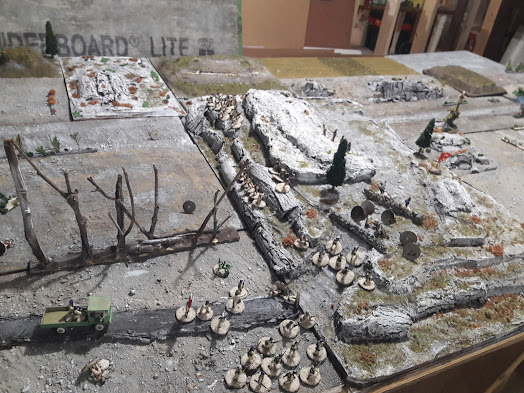Here is an after action report of my first play through of Scenario 2: Skirmish as Picacho Pass. February 8, 1911
From the campaign game I'm developing: Sueños de Libertad: Scenarios for the PLM’s Baja Campaign in the Mexican Revolution, 1911.
This was a striaight-forward conflict with only one objective: control the mountain pass. I threw a couple wrinkles into the scenario: For the Federal Forces their volunteer conscripts could route at the first sound of fire with a low roll, and both sides would receive reinforcements at turn five, pending a roll of 4 or above on a D6.
The 22 Cocopah revolutionaries stood on top of the mountain. They could not see any approaching enemy, due to the heavy rain that reduced visibility to just 10". The defenders broke into 2 groups. One moved down the mountain, 5 holding a line of trees as an ambush point, the rest covering them from the ridgeline. The second group of defenders focused on building stone barricades across the pass.
The Federales advance rapidly. I used a die-generation system to determine orders for opposing forces for solo games. When creating the Federal platoons' orders, the D6 landed over and over on 5: full frontal charge. The only deviation on those orders for the 6 platoons and HQ group was one platoon, whose orders were to reinforce the most advanced unit...which was charging. The Government forces, thus, rushed across the desert toward the Cocopah Mountains, with the platoon of "volunteers" up front to absorb bullets.
The ambushers dropped further back, taking cover behind a line of fallen trees.
Colonel Vega quickly regained control of the situation. He rallied his spooked first platoon, and spread the platoons out to advance on a broad front. The conscripts, however, fled the scene.
The advanced group lands a couple more shots, but they are spitting at the rain. They flee up the hill in the face of the advancing platoons. The Cocopah leader sends the first group north along the side of the mountain, hoping to guard that flank and also keep the way open, in case the detachment of radical workers from the United States union, Industrial Workers of the World, were able to arrive in time.
This seemingly cautious plan turned out to be a terrible blunder. The Federal platoons rushed forward, with two platoons coming into view of the first group of revolutionaries, themselves split into two sections on the ridge.
The Federal soldiers fire first, and all but obliterate the first group. Only three rebels survive the volley.
Similarly, the first volley on the south end of the line fells most defenders at the first barricade. The Cocopah leader attempts to move the second group into good firing positions, and the soldiers rush up the mountain.
The Indigenous revolutionaries fire at the onslaught of soldiers as best they can, but the nothernermost platoon of Federales hooks around the top of the mountain, outflanking the Cocohaps. There is nothing left for them to do but run east toward their comrades.
Just then, the IWW contingent arrives just in time. Their delegate lines the men up behind some ridges, and the catch the flanking platoon of soldiers off guard and exposed. Two rounds of accurate fire breaks the platoon, the lone survivor setting off on an epic sprint through the desert back to Ensenada. The US workers rush up the north face of the hill to assist their comrades.
Meanwhile, on the soouth-west end of the pass, Vega's soldiers are making steady progress. They push up to the second barricade clear the first away and rally their forces at the top of the mountain.
The survivors of the second Cocopah group are chased from the summit. They rally behind a small hill to the east.
The Wobblies (IWW members) repeat the blunder of the men they had just defeated, and run across the open face of the mountain. Unfortunately, they did not see the platoon of soldiers on the peak above them.
Not wanting to walk into another ambush in the torrential downpour, Vega takes a turn to reorganize his forces. The platoons spread out and approach the edge of the mountain together. The second hill comes into range, and the soldiers fire accurately, cutting down the fleeing wobblies and forcing the Cocopah's to withdraw. For the revolutionaries, the game is no longer about holding the pass, that cause is lost. Now, the rebels can only hope to escape to fight again.

The IWW survives have almost reached the line!
The Cocopah revolutionaries at the tree line fire on the Federales. Again, they are able to force the conscripted volunteers to route but it is too little too late. The Government forces fire on the tree line, and the local Natives retreat off the table.

Only two IWW men remain, the delegate and standard bearer. They race toward safety, but the Federales catch up with them and gun them down. No prisoners, as Vega had ordered.
The game draws to a close. Its a clear victory for the government forces, though also a pyrrhic victory. 8 Cocopah Indians escaped, and of the 77 Federal forces and conscripts engaged in the battle, only 24 soldiers and 3 conscripts remain under Vega.
In my research, I could not learn much about what actually happened here in the historic event, other than Vega took no prisoners. I don't think IWW reinforcements arrived, and I assume some Cocopahs survived to warn the Mexicali group, as their defenses were well-lain when Vega arrived the following week. I could learn nothing of Vega's casualties, other than that many conscripts deserted.
Check back for the next scenario in a few days:





































No comments:
Post a Comment